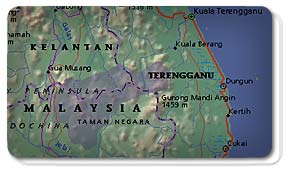|
|
|
The Forest Through the Trees
 | Map of where we are. |
Malaysia is not known for its sites of historical
magnificence. The architectural wonders of South East Asia:
Angkor Wat, Ayutthaya, Borubudor and Bagan, are found in neighboring
countries. And to be brutally honest, after seven months of
travel, Will and I had seen our fair share of temples, mosques,
colonial architecture and other lesser-known sites. On more
cynical days we had even thought of renaming our journey the
"Tour of UNESCO World Heritage Sites." While in
Malaysia, we wanted to experience nature. The great outdoors
beckoned.
 | Click to Enlarge. |
From a rickety wooden pier in the middle of
nowhere, we began our journey. A five-seater, 100cc speedboat
cruised over the calm deep blue of the South China Sea. Our
destination was Pulau Perehentian, islands located 20 km off
the northeast coast of Malaysia. As we approached, two lusciously
green mounds, ringed with white sand, lackadaisically rose
from the water. We had arrived at Pulau Perehentian Kecil
(Small) and Besar (Large).
The boat driver pulled right up onto Long Beach on Kecil. A few people lay on the wide swath of sand. Others frolicked in the glass-like water. Hopping out of the boat, backpacks in tow, it seemed we had arrived at paradise.
 | Click to Enlarge. |
Snorkeling, swimming and diving was how we spent our six days on the island. Brilliant coral colonies reside at the ends of Long Beach and on small pinnacles near the island. They are home to an amazing array of marine life. We spotted stingrays, moray eels, bamboo sharks, turtles, hundreds of species of tropical fish, gazillions of invertebrates and yes, a whale shark. Each time we went in the water we came face-to-face with a creature we had not yet encountered.
 | Click to Enlarge. |
Our excitement and exhilaration dampened though
after a few days. Paradise was being tainted by the very people
who had come to experience it. Upon closer inspection, the
reef outside our hotel was dying. Algae, caused from untreated
runoff from hotels, were forming on the coral. Brilliant blues,
pinks and greens were being replaced by deadly browns and
whites. The coral, an animal is its own right and home to
thousands of others, was slowly being choked to death by the
people who were coming to admire and those who hoped to profit
from it.
 | Click to Enlarge. |
While taking the cross-island jungle path, we heard a loud rustling. Hoping to see one of the large monitor lizards that reside on the island, we went to investigate. We saw three of the beautiful meter-long (3 foot) reptiles. Unfortunately, they were routing through huge piles of plastic and other human waste.
 | Click to Enlarge. |
The Perehentians, in addition to being a Marine Park, are also a protected breeding ground for Hawksbill Turtles. To this end, an organization has chickenwired a tiny plot of land on the beach to protect the eggs. While noble, it saddened us to think that the turtles had been relegated to this tiny spot on what was once their entire beach. Furthermore, about 10 of the tiny baby turtles had not been released. They had been left to bake in a bucket so tourists could see them, of course, struggling to escape.
 | Click to Enlarge. |
While still undoubtedly stunning, the Perehentians are losing their pristine shine. Like so many other places we have visited, destinations that purport to be eco-tourist, are definitely not. In Thailand, the sharks and rays we tried so hard to spot while underwater lay lifeless on ice. They had ended up as dishes at many local restaurants. In Vietnam, there are hardly any fish left due to dynamite and cyanide fishing. Throughout the entire region fisherman, boat operators and careless tourists have permanently scarred and destroyed reefs. Nets, plastic bags and boat anchors were consistently found tangled up in the coral. As one divemaster explained to us in Thailand, the islands are designated Protected Marine Parks in name only. They are 'protected' to lure tourists, but there is no enforcement and barely any education.
Dive shops such as Turtle Bay on the Perehentians
and Jeremy Stevens' Rainbow Divers in Nha Trang, Vietnam,
are spearheading local protection efforts. Unfortunately,
their work is being met with little help from local authorities.
 | Click to Enlarge. |
We left the islands and sought out the jungle to find solace. Taman Negara, a Malaysian National Park was our next stop. At 130 million years old it is purportedly the oldest rainforest in the world. It is not within the path of any large volcanoes nor was it effected by the ice age. More crucial to its preservation though, is that the 4343 square kilometers (2700 square miles) of Taman Negara have never been logged.
 | Click to Enlarge. |
Massive trees towered overhead creating a
dense dark green canopy. Below their buttressed roots supported
the soil and a bounty of other species of plants. Prehistoric
looking ferns spanned the spectrum from light grass to blue
to deep forest green. Ruby red, chocolate brown and creamy
white fungus clung to decaying vegetable matter producing
a heady earthy smell. Occasionally sighted brightly hued wildflowers
added a pleasant perfume. Hornbills swooshed overhead, their
loud wing flapping alerting us to their presence. Howler monkeys
hooted while a constant symphony of bugs and smaller birds
called out in nature's magnificent surround sound.
|
